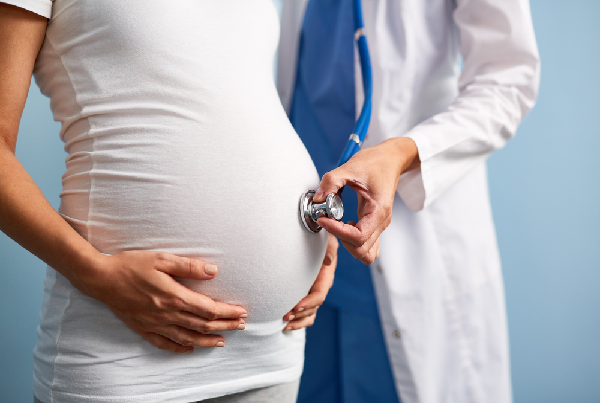
Obstetrics
- Preconceptional counseling
PRECONCEPTIONAL VISIT, RISK ASSESSMENT, AND EDUCATION
- Identification of high-risk factors by detailed evaluation of obstetric, medical, family, and personal history.
- Risk factors are assessed by laboratory tests if required.
- Base-level health status including blood pressure is recorded.
- Rubella and hepatitis immunization in a nonimmune woman are offered.
- Folic acid supplementation (4 mg a day) starting 4 weeks prior to conception up to 12 weeks of pregnancy is advised.
- Problems of overweight, underweight, anemia, and abnormal Papanicolaou smears are evaluated and treated appropriately.
- Preexisting chronic diseases (hypertension, diabetes, epilepsy) are stabilized in an optimal state by intervention. For example, anticonvulsant drugs are checked, warfarin is replaced with heparin, and oral antidiabetic drugs are replaced with insulin.
- Women should be urged to stop smoking, taking alcohol, and abusing drugs. An addicted woman is given specialized care.
- Couples with a history of recurrent fetal loss or with a family history of congenital abnormalities (genetic, chromosomal, or structural) are investigated and counseled appropriately.
- Antenatal Advise
Diet: The diet during pregnancy should be adequate to provide: (a) good maternal health, (b) optimum fetal growth, (c) the strength and vitality required during labor, and (d) successful lactation. During pregnancy, there is an increased calorie requirement due to increased growth of the maternal tissues, fetus, and placenta, and increased basal metabolic rate.
The pregnancy diet ideally should be light, nutritious, easily digestible, and rich in protein, minerals, and vitamins.
Supplementary Nutritional Therapy: supplementary iron therapy is needed for all pregnant mothers from 16 weeks onwards. Above 10 g% of hemoglobin, 1 tablet of ferrous sulfate (Fersolate) containing 60 mg of elemental iron is enough.
- Antenatal Hygiene:
Rest and Sleep: The patient may continue her usual activities throughout pregnancy. However, excessive and strenuous work should be avoided especially in the first trimester and the last 4 weeks. Recreational exercise (prenatal exercise class) is permitted as long as she feels comfortable. There is an individual variation in the amount of sleep required.
Bowel: Constipation is common. It may cause backache and abdominal discomfort. Regular bowel movement may be facilitated by regulation of diet taking plenty of fluids, vegetables, and milk, or prescribing stool softeners at bedtime.
Bathing: The patient should take a daily bath but be careful against slipping in the bathroom due to imbalance. The patient should wear loose but comfortable garments. High heel shoes should better be avoided in advanced pregnancy when the center of balance alters. The constricting belt should be avoided.
Dental Care: Good dental and oral hygiene should be maintained. The dentist should be consulted, if necessary.
Care of the Breasts: Breast engorgement may cause discomfort during late pregnancy. A well-fitting brassiere can give relief.
Coitus: Generally, coitus is not restricted during pregnancy. Release of prostaglandins and oxytocin with coitus may cause uterine contractions. Women with an increased risk of miscarriage or preterm labor should avoid coitus if they feel such increased uterine activity.
Travel: Travel by vehicle having jerks is better to be avoided, especially in the first trimester and the last 6 weeks. The long journey is preferable to be limited to the second trimester. The rail route is preferable to the bus route. Travel in pressurized aircraft is safe for up to 36 weeks. Air travel is contraindicated in cases with placenta previa, preeclampsia, severe anemia, and sickle cell disease. Prolonged sitting in a car or airplane should be avoided due to the risk of venous stasis and thromboembolism. A seat belt should be under the abdomen.
Smoking and Alcohol: Smoking is injurious to health, it is better to stop smoking not only during pregnancy but even thereafter. Heavy smokers have smaller babies and there is also more chance of abortion. Similarly, alcohol consumption is to be drastically curtailed or avoided, so as to prevent fetal maldevelopment or growth restriction.
Tetanus: Immunization against tetanus not only protects the mother but also the neonates. In unprotected women, 0.5 mL tetanus toxoid is given intramuscularly at 6 weeks intervals for 2 such, the first one to be given between 16 and 24 weeks
- What to Expect During the Visit
First Visit
The initial antenatal examination should be carried out in the first trimester. At this examination, a record is kept of the size of the uterus by ultrasonography. This is of immense help in estimating the correct duration of gestation in the last trimester.
Fetal well-being depends on satisfactory maternal health throughout pregnancy. After a thorough clinical examination of the mother, the investigations are initiated as early as possible.
Subsequent Visit
- Maternal Weight Gain: During the second half of pregnancy, the average weight gain is 1 kg a fortnight.
- Blood Pressure: Initial recording of blood pressure prior to 12 weeks helps to differentiate pre-existing chronic hypertension from pregnancy-induced hypertension developing later o
- Assessment of the Size of the Uterus and Height of the Fundus: In the early weeks, the size of the uterus is of great value in confirming the calculated duration of gestation. The height of the fundus is documented at each visit.
- Antenatal Assessment of Fetal Well-Being
About 50% of first-trimester spontaneous abortions and about 5% of stillborn infants have a chromosomal abnormality.
5. Screening Method
First Trimester Screening
Screening Parameters Are (A) Biophysical: (i) ultrasound measurement of nuchal translucency (NT),
(ii) Nasal bone, (B) Biochemical: (i) free β-hCG, (ii) PAPP-A (Pregnancy Associated Plasma Protein-A).
Time of Test: Between 11 weeks and 14 weeks.
(i) genetic; (ii) Chromosomal and (iii) structural abnormalities
Advantages: Once a woman is screened positive, diagnostic tests should be done early. A targeted ultrasound examination during the second trimester and fetal echocardiography is to be done when NT is ≥ 3 mm.
Second Trimester Screening
It is done between 15 weeks and 22 weeks.
Triple Test: It is a combined biochemical test that includes MSAFP, hCG, and uE3 (unconjugated estriol).
Quadruple (Quad) Screening Includes Four Biochemical Analytes: (1) Maternal Serum Alpha-Fetoprotein (MSAFP), (2) Unconjugated estriol (uE3), (3) dimeric inhibin-A, and (4) hCG. The quad screen can detect trisomy 21 in 85% of cases with a false-positive rate of 0.9
The best screening procedure is combined first and second-trimester procedures (ACOG).


